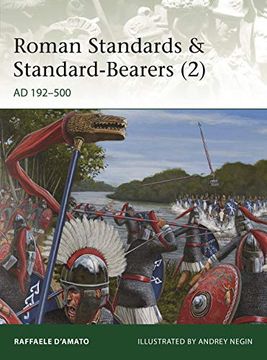Compartir
Roman Standards & Standard-Bearers (2): Ad 192–500 (Elite) (en Inglés)
Raffaele D&Rsquo;Amato (Autor)
·
Osprey Publishing
· Tapa Blanda
Roman Standards & Standard-Bearers (2): Ad 192–500 (Elite) (en Inglés) - Raffaele D&Rsquo;Amato
$ 35.181
$ 58.635
Ahorras: $ 23.454
Elige la lista en la que quieres agregar tu producto o crea una nueva lista
✓ Producto agregado correctamente a la lista de deseos.
Ir a Mis Listas
Origen: Estados Unidos
(Costos de importación incluídos en el precio)
Se enviará desde nuestra bodega entre el
Martes 25 de Junio y el
Jueves 04 de Julio.
Lo recibirás en cualquier lugar de Argentina entre 1 y 3 días hábiles luego del envío.
Reseña del libro "Roman Standards & Standard-Bearers (2): Ad 192–500 (Elite) (en Inglés)"
This book draws upon the latest research to identify, explain, and illustrate the standards used by the Roman armies of the Late Empire.The Late Roman Empire was a period of significant change in the designs of standards and in the costumes of standard-bearers. During the middle decades of the chaotic 3rd century, evidence confirms the continued use of the old legionary eagle and the signa of the old cohorts and centuries, alongside flags and Imperial images. The two major trends over the later generations were the adoption of Christian symbols on standards (e.g. Constantine the Great's Chi-Rho), and the proliferation of different types of flags. This had begun in the late 2nd century with the adoption of the “barbarian” dragon standard, the windsock-shaped draco, which continued to be displayed, alongside various other flags in the Greek-speaking Eastern Empire, whose influence increased greatly. Meanwhile, the growing employment of foreign units was such that by the 5th century we have evidence of the use of Hunnic symbolism among a Roman general's suite of standards. The costumes of standard-bearers also evolved as “Persian” styles spread from Constantinople. This title explores all these changes in depth, charting the development of various costumes and designs and the waxing and waning influence of various cultures and religious considerations. The text is supported by specially commissioned illustrations and artist's reconstructions of the standards and their bearers.
- 0% (0)
- 0% (0)
- 0% (0)
- 0% (0)
- 0% (0)
Todos los libros de nuestro catálogo son Originales.
El libro está escrito en Inglés.
La encuadernación de esta edición es Tapa Blanda.
✓ Producto agregado correctamente al carro, Ir a Pagar.

